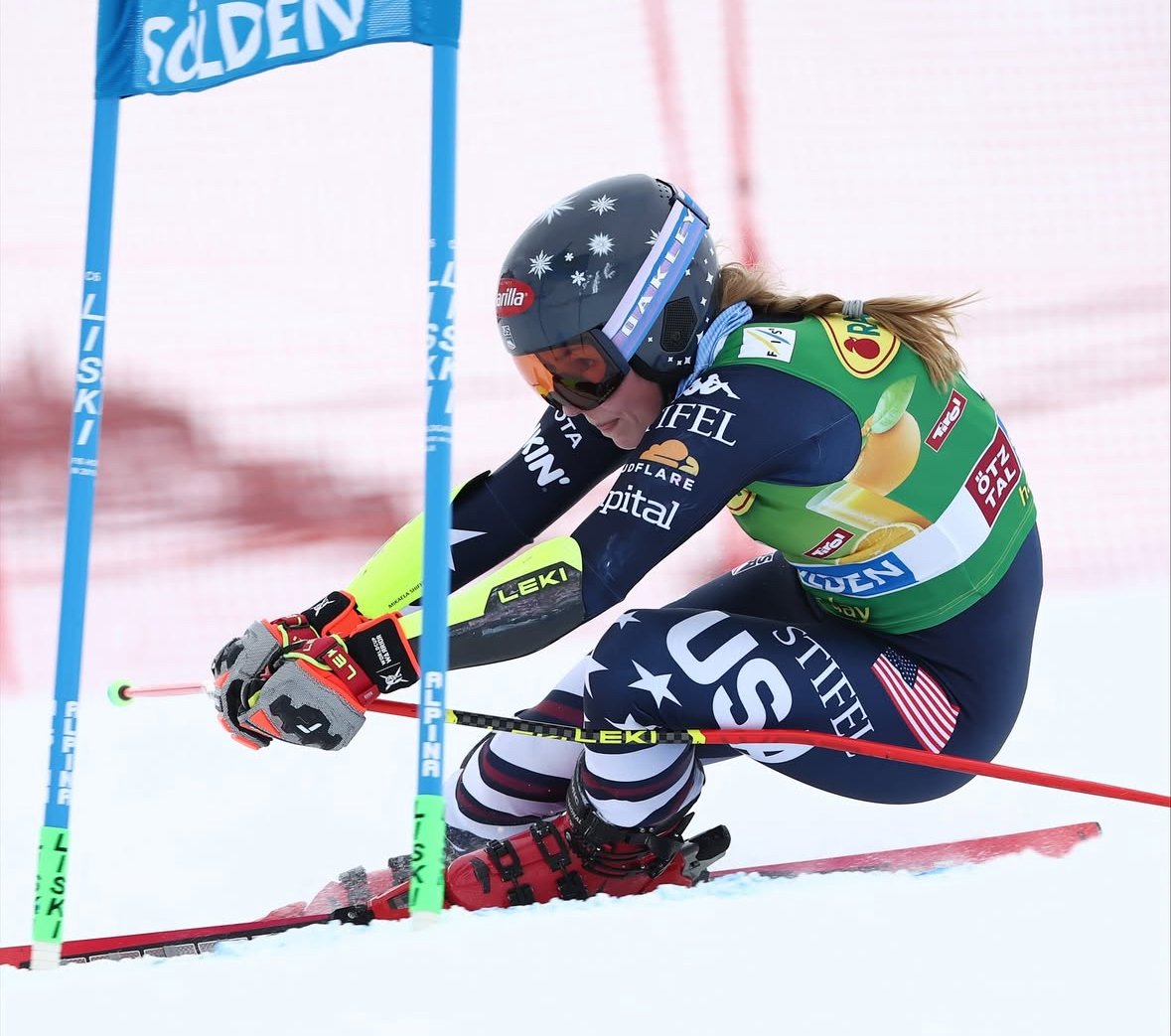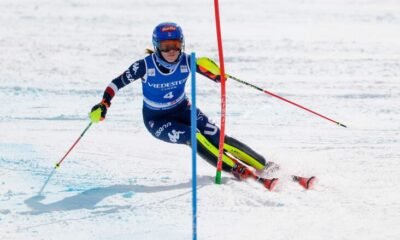Blog
Can Mikaela Shiffrin Deliver a Comeback Win in Her Next Race? The Numbers Suggest It’s…
Mikaela Shiffrin has built her career on the art of comebacks. Whether it’s recovering from a tough run, rebounding from injury, or returning after emotional setbacks, the American skiing superstar has a way of turning challenges into fuel. As the 2025–26 FIS Alpine Ski World Cup season unfolds, all eyes are once again on her. After a fourth-place finish in the season opener at Sölden, the question is simple: can Shiffrin deliver a comeback win in her next race? The statistics — and history — seem to say yes.

Mikaela Shiffrin finished in strong 4th place at Sölden. | Image: FIS
A Familiar Starting Point
For most athletes, finishing just off the podium in the first race of the year would feel bittersweet. For Shiffrin, it’s business as usual. Over her illustrious career, she’s often used early-season races to calibrate her form, refine her timing, and build momentum. In the 2018–19 season, she also started cautiously before winning 17 World Cup races that winter — a record still unmatched.
Her opening performance this time around, solid but imperfect, was a reminder that the Alpine World Cup season is a marathon, not a sprint. “It’s a good start,” she said after the race in Sölden. “There’s always more speed to find, but that’s why we race — to keep improving.”
That steady mindset, coupled with her unparalleled technical precision, has always been Shiffrin’s foundation. And it’s exactly why a comeback win could be just around the corner.
The Numbers Don’t Lie
If there’s one thing that defines Mikaela Shiffrin’s greatness, it’s consistency. According to FIS data, she finishes in the top five nearly 70 percent of the time she starts a World Cup race. In slalom — her strongest discipline — she podiums almost eight out of every ten times she competes.
When you dig deeper into her career stats, the trend becomes even clearer: whenever Shiffrin misses a podium in her first race of the season, she tends to win the very next one. She did it in 2016 after finishing fifth in Sölden, then winning Levi. She repeated that pattern in 2021, rebounding from a non-podium start to win just two weeks later.
So if the data tells us anything, it’s that Shiffrin’s current trajectory is right on schedule.
The Challenge Ahead
Her next major test will likely come in Levi, Finland — a venue that has been almost synonymous with her dominance. She has won there six times, tying the record for most victories at a single World Cup location. The Levi Black slope fits her style perfectly: it’s technical, rhythm-based, and rewards athletes who can manage the changing terrain and light conditions with precision.
Shiffrin’s smooth control and impeccable edge work have long made her a favorite there. But the 2025–26 field is fierce. Rivals like New Zealand’s Alice Robinson and Italy’s Federica Brignone have been closing the gap in the technical events, and young Swiss talent Lara Gut-Behrami remains a constant podium threat.
Still, no one in the sport matches Shiffrin’s ability to analyze, adjust, and execute under pressure. As her coach put it recently, “You can beat Mikaela once, maybe twice. But if she’s healthy, you won’t beat her three times in a row.”
The Comeback Formula
Comebacks, in skiing, are not built on emotion alone. They’re the result of data, discipline, and meticulous preparation — all areas where Shiffrin excels. Her team uses a combination of video analysis, course data, and weather modeling to prepare for every event. Between races, she’s known to study slow-motion replays of her own runs frame by frame, searching for minor inefficiencies most skiers would never notice.
“She’s always learning,” said one U.S. Ski Team insider. “Even after a fourth-place finish, she treats it like a win if she discovers what she can improve next time.”
That mindset is what makes her so dangerous. Unlike some competitors who see a missed podium as a setback, Shiffrin treats it as raw material — something to mold into a better performance the next time she clips into her skis.
Emotional Strength: The X-Factor
Beyond stats and technique, there’s an emotional layer to Shiffrin’s resilience that continues to define her. The passing of her father, Jeff Shiffrin, in 2020 changed her perspective on racing. She has often spoken about how his advice — to stay grounded and focus on the process, not the outcome — still guides her today.
“Dad always told me that skiing is about moments,” she said in a recent interview. “You can’t win every race, but you can find joy in every run. That’s what keeps me going.”
That emotional grounding may be her biggest weapon as she looks toward Levi. When the pressure builds, Shiffrin doesn’t crumble — she channels it. And in comeback scenarios, that calm focus has a way of translating into brilliance.
Rivals Rising, But Pressure Is Her Playground
Federica Brignone and Petra Vlhová are two names that often come up when discussing who might challenge Shiffrin this season. Brignone’s aggressive style and home-nation motivation heading into the 2026 Winter Olympics in Italy make her a formidable rival. Vlhová, meanwhile, remains one of the few skiers capable of matching Shiffrin’s slalom precision on her best day.
But history suggests that the higher the competition level, the sharper Shiffrin becomes. Her win percentage actually increases in Olympic and World Championship seasons — proof that she thrives when the stakes are highest.
“She doesn’t chase the race,” said NBC analyst Steve Porino. “She lets the race come to her. That’s how you recognize greatness — it’s not reaction, it’s control.”
What a Comeback Win Would Mean
A win in her next race would do more than just boost her points in the standings — it would send a message. It would remind the field that even when Shiffrin isn’t at her absolute best, she’s still the benchmark. It would also serve as the perfect launchpad for a season that will build toward the Milan-Cortina 2026 Olympics, where she’ll look to add to her already historic medal haul.
More importantly, it would reinforce the story fans have come to love: that of an athlete who doesn’t let adversity define her, but rather uses it as fuel.
The Verdict
So, can Mikaela Shiffrin deliver a comeback win in her next race? Everything — from her data to her demeanor — says yes. She’s healthy, she’s motivated, and she’s entering a venue where she has historically been unstoppable.
If there’s one certainty in ski racing, it’s that Mikaela Shiffrin never stays off the top step for long. And as history has shown time and again, when she finishes just outside the podium, it usually means the world should brace for something spectacular next time.
Fans don’t have to wonder if she’ll win again — only when. And with her next race just around the corner, that answer might come sooner than anyone expects.
Impressive performance by Team USA, as Paula Moltzan places second and Mikaela Shiffrin places fourth
 Mikaela Shiffrin finished in strong 4th place at Sölden. | Image: FIS
Mikaela Shiffrin finished in strong 4th place at Sölden. | Image: FIS
And we’re back—the FIS Alpine World Cup season has begun, and Austria has won its first World Cup Giant Slalom in years. Paula Moltzan finished second, with veteran skier Lara Gut-Behrami taking third place.
The morning began with run 1 at 9 a.m.—after previous snowfalls and stormy weather, the weather gods were kind and turned on the sun on the Rettenbach Glacier. While the top part was windy and visibility fluctuated, overall conditions were excellent. On the team radio, Paula Moltzan characterized the snow as “the easiest she had ever skied”.
Team USA delivered a tremendous performance. Six of the eight starters in the gate qualified for run two. Giant Slalom races are divided into two runs, with the fastest 30 skiers from the first qualifying for the second.
 Paula Moltzan claimed 2nd place at Sölden. | Image: FIS
Paula Moltzan claimed 2nd place at Sölden. | Image: FIS
Paula Moltzan took second place at Sölden. | Image:
FIS Run 1.
Thea Louise Stjernesund of Norway was the first out of the gate, going aggressively into the race but losing time in the softer middle section. She set the pace on the Rettenbach Glacier today, finishing in 1:09.67 minutes. Albania’s Lara Colturi was the next to start, and she did so with the best bib number of her career. Colturi was determined to make it count, skiing faster on top by two tenths of a second. She increased her lead over Stjernesund into the middle part and, with a low tuck, gained more than a half-second on the Norwegian. Colturi’s lead was short-lived, as Croatia’s Zrinka Ljutić beat her by only 0.02 seconds.
Team USA’s Paula Moltzan on bib 4 took the lead with an aggressive and frantic run, finishing 0.04 seconds ahead of Ljutić. Sara Hector, Lara Gut-Behrami, and Alice Robinson all failed to unseat the three leading ladies.
The leader group appeared determined, with only 0.06 seconds separating the fastest three women of the first seven starters, but local favorite Julia Scheib, who had podiumed in Sölden last year, stunned the elite group of top seven skiers with an incredible run that was 1.28 seconds faster. The home crowd went wild when the Austrian crossed the line with such a huge lead. The leader’s position in the finish area was hers, and no following skier came close to challenging it.
Mikaela Shiffrin, with bib 20, was starting with the highest bib number in 13 years, following her November fall at Killington. Shiffrin ran a tremendous race, regaining her racing form and finished sixth in run 1 despite her high bib number. The 30-year-old’s face was filled with relief as she gave a fist bump near the finish line. She’s back! Her PTSD is behind her.
Other standout performances from run 1 were Katie Hensien, who finished ninth in bib 25, dropping teammates Nina O’Brien to 15th and A J Hurt to 18th. Also qualifying from Team USA was Elisabeth Bocock who finished run 1 in 24th place.
Clara Direz of France finished 23rd with bib 36, while Finland’s Erika Pykäläinen showed that you can still qualify with a bib 42, finishing 29th, one position ahead of Austria’s Katharina Liensberger.
 Lara Gut-Behrami claimed 3rd place at Sölden. | Image: FIS
Lara Gut-Behrami claimed 3rd place at Sölden. | Image: FIS
Run 2
Run 2 is performed in reverse order. Liensberger, who finished in 30th place, led the way in Run 2. With a timing of 1:08.33 minutes, the Austrian demonstrated that run 2 can really be quicker than run 2. Pykäläinen came up next and skied into the lead, defeating Liensberger’s combined time by 0.46 seconds, giving the Finnish skier her second career World Cup point. She got to enjoy her time in the leader’s position at the finish area for another four skiers, as the next few women were unable to displace her. Bocock of the United States snatched the lead from Pykäläinen, and the American held on for three more skiers, culminating in a Top 20 finish for Bocock—his personal best Giant Slalom finish at the age of twenty.
Team USA’s AJ Hurt, as the 13th starter, took the lead from Asja Zenere and Maryna Gasienia-Daniel, who had been tied until then, with a 0.62-second quicker time. Hurt spent some time in the leader’s seat as well, but was ousted by her teammate O’Brien, who defeated her by 0.39 seconds. She held on to her lead for six more skiers, defeating Robinson, Grenier, and comrade Hensien. But then it was time for Stjernesund, who finished run 1 in seventh place (tied with Sweden’s Hector). The Norwegian took the lead by 0.22 seconds, defending her combined time against the Swedish.
Mikaela Shiffrin, who had proven on run 1 that the American ski racer is back in top racing condition, finished sixth and exhibited the consistency that we have come to expect from the 30-year-old, taking the lead by 0.11 seconds. Shiffrin was ecstatic, even though there were only five skiers left. Today’s race was more about regaining her confidence and form.
Gut-Behrami, the fifth last skier, quickly took the lead by 0.31 seconds over Shiffrin, demonstrating that just because she had stated her plan to retire after this season did not mean she was going to slow down any sooner. Colturi, who had the fourth fastest run in the first, struggled to maintain the same level of intensity in the second. It was a clean and easy run, but not fast enough to make the podium today.
This left only three skiers to go—a podium was far from guaranteed for Gut-Behrami as she watched Ljutiç frantically weave down the Rettenbach glacier, but the Croatian lost time on the second half of the course and was unable to take the speed across the finish line. Switzerland had a guaranteed spot on the podium; the only question was which position.
 Julia Scheib won the season opener at Sölden. | Image: FIS
Julia Scheib won the season opener at Sölden. | Image: FIS
Paula Moltzan, the second-last skier, raced out of the gate and demonstrated her intent to win. She stretched her lead by a full second, but a slide in the midsection cost her vital milliseconds. However, there was enough lead and speed to bring it to the finish line, and Moltzan beat Gut-Behrami and Shiffrin by 0.53 seconds.
This left only the home favorite Julia Scheib to compete, and she proved that run 1 was not a fluke. While she lost up some of her 1.28-second lead on Moltzan, she maintained her lead and reached the finish line 0.58 seconds ahead of the American. This was Austria’s first triumph at Sölden in 11 years, and Scheib’s first World Cup victory. The home fans went wild as the Austrians began the 2025-26 season with a home win after a long drought.
It was also a big day for Team USA, with six finishers in the top 20, five in the top 15, and three in the top 6. Best of all, Shiffrin has demonstrated that she has overcome her PTSD, and we are looking forward to a thrilling 2025-26 season.
 Julia Scheib claimed her first-ever career podium. at Sölden. | Image: FIS
Julia Scheib claimed her first-ever career podium. at Sölden. | Image: FIS
-

 Blog4 months ago
Blog4 months agoPat Kelsey sends a strong three-word fiery message to the Louisville basketball’s team after their Cardinals 14th win…
-

 Blog7 months ago
Blog7 months agoNetflix releases “The Underdog,” a much-anticipated documentary about Drew Brees. slated for publication on the 25th
-

 Blog4 months ago
Blog4 months agoMikaela Shiffrin responds to cross-country skier Jessie Diggins’ letter following her failure to secure a solitary podium finish at the FIS Nordic Worlds
-

 Blog2 months ago
Blog2 months agoBehind the Turns: Netflix’s Upcoming Documentary on Mikaela Shiffrin’s Fights, Fears, and Love
-

 Blog4 months ago
Blog4 months agoWomen’s Slalom Run 1 at the FIS Alpine Skiing World Cup: Are
-

 Blog4 months ago
Blog4 months agoLegacy Tour Led Zeppelin has officially confirmed their 2026 reunion tour, which will be their first extensive live performances since 2007. The “Led Zeppelin Legacy Tour 2026” will begin on June 10, 2026, at Los Angeles’ SoFi Stadium.
-

 Blog6 months ago
Blog6 months agoFederica Brignone: “I’m fine, but my return to skiing is far off.”
-

 Blog6 months ago
Blog6 months agoAlice Cooper: From Fragile Boy to Shock Rock Icon—Netflix Unmasks the Nightmare
